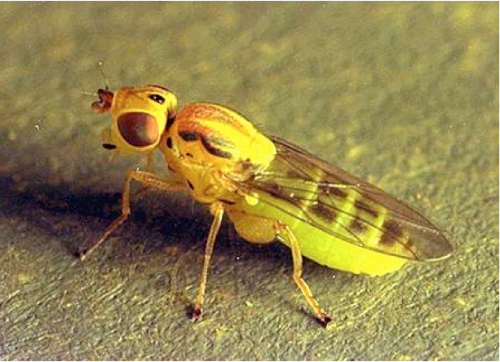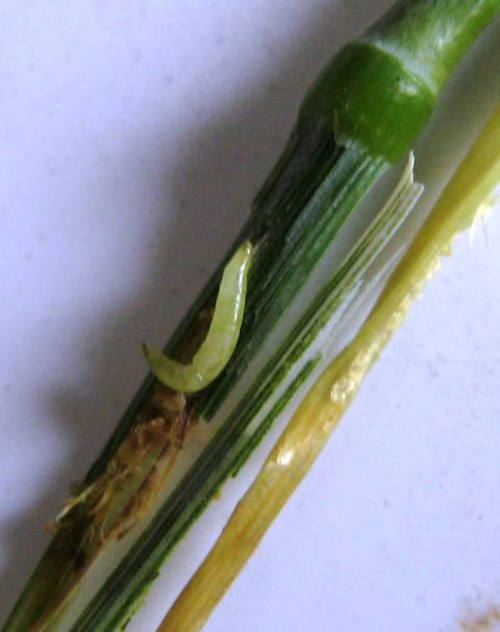Wheat Stem Maggot
Meromyza americana
The wheat stem maggot is found in wheat growing regions from Mexico to Canada. Damage is evident from May through June in the form of conspicuous white heads on stems where the flag leaf is still green. Although this insect is widespread and produces a very distinctive type of damage, it is usually considered to be a minor pest problem.
|
Adult fly. |
Wheat heads 'bleached' by maggot feeding. |
|
Stem dissected to reveal stem maggot. |
|
Life History
The wheat stem maggot passes the winter in the larval stage, in the lower parts of the stems of wheat and other hosts. They pupate in the spring and the adults emerge in May. Eggs are laid singly on the leaves near the stem. These eggs hatch into green colored maggots which feed inside the stem of the upper most joint of the host plant. The first indication of the larvae is the dying out and whitening of the head and upper stem while the flag leaf is still green. These white heads can easily be pulled from the plant revealing an inch or two of browned and tunneled stem a few inches below where the leaf sheath of the flag leaf would have been attached. The damage is fairly distinctive because of the white heads without kernels on a still green plant. Another generation of flies emerges in midsummer to lay eggs on volunteer and other grasses. The fall generation emerges in late August to early September and lays eggs in the new winter wheat crop.
Description
The adults are yellowish-white flies about 1/5 inch long, with three conspicuous black stripes on the thorax and abdomen and with conspicuous bright-green eyes. The larvae are greenish maggots about 1/4 inch in length.
Host Plants
Wheat stem maggots attack cereal crops, including wheat, rye, barley, and oats. Other hosts include bluegrass, millet, timothy, and a range of other native and introduced grass species. Corn is some times damaged when planted into infested cereal crop residue that has been grazed or sprayed out in early spring.
Management Practices
The use of delayed planting, following the dates recommended to escape Hessian fly infestations, is an effective management practice. Destruction of volunteer plants is also recommended. The effectiveness of chemical control is unknown. Currently, we do not have the knowledge to time such applications properly. Fortunately, damage rarely exceeds 1 to 2 percent of the heads and is usually considered inconsequential.
Phillip E. Sloderbeck, J.P. Michaud, and R. Jeff Whitworth
Page last updated 10/30/2013 by J.P. Michaud.


